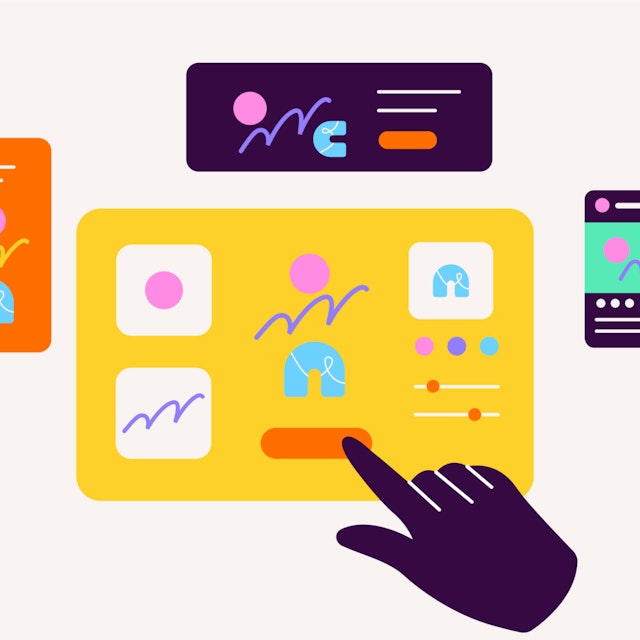11 Reasons Why You Should Use Creative Automation
Why creative teams are automating repetitive work—and how AI tools like Visual help them scale without breaking brand.
Written byMichaela Brown
Updated onJune 5, 2025

Content is scaling—your team can’t do it all manually
Creative teams aren’t just expected to be brilliant and creative at the drop of a hat. They’re expected to be fast, consistent, and everywhere at once. But most visual workflows weren’t built for that kind of scale.
Enter creative automation: tools and workflows that take the minutiae out of asset production, so your team can focus on moving the needle.
Key takeaways
Creative automation doesn’t replace design teams—it frees them up
Scaling content doesn’t have to mean sacrificing brand
Visual is built to help teams automate the visual stack intelligently
What is creative automation?
Creative automation refers to tools and workflows that help designers and marketers produce assets faster and more efficiently. These tools enable designers and marketers to scale their work and keep it on brand without sacrificing quality.
To be clear, creative automation isn’t meant to replace humans; it’s meant to free them from repetitive tasks so they can focus more on creative and strategic thinking.
Who needs creative automation most?
Creative automation is for anyone who needs to create on-brand assets quickly without sacrificing quality. But if you’re one of these people, you probably need creative automation the most:
Content marketers who publish content on multiple channels
Designers bogged down with one-off requests
Founders and PMs who need to look polished without design support
11 reasons to use creative automation tools now
1. Free your team from pixel-pushing
Does pixel-pushing prevent your team from using their skills to solve problems and delight customers? Of course, pixel-pushing is a part of the overall craft, but don’t let it bog you down. Creative automation and AI tools can perfect and polish a design in seconds, allowing your team to focus on high-level strategic work.
2. Stay consistent everywhere
Consistency across platforms is key to making your brand a household name. Consider automating consistency with brand templates. Guardrails like brand templates allow non-designers to create graphics as needed without bogging down designers in ad-hoc requests.
3. Move faster without breaking things
Creative automation can alleviate workers when they’re expected to produce more with less. Tools to automate repetitive and tedious tasks will help designers work faster. This will allow them to shorten production cycles and stay on top of trends.
4. Eliminate human error
We all make silly mistakes; it’s okay. Creative automation will save you the hassle of going back and fixing things. With Visual, you won’t have to worry about ensuring your logos are in the right place, if your colors are on brand, or double-checking aspect ratios.
5. Scale visual content without scaling your team
According to a survey from CommsCo, 63% of marketers say they’re expected to do more with less. Employing creative automation can help marketers to do more with less. An AI tool, for example, can create multiple outputs, in multiple formats, for multiple channels from one prompt.
6. Collaborate in real-time, no design bottlenecks
In 2025, it’s not uncommon to be in a different physical location from the rest of your team. Eliminate bottlenecks from asynchronous work with tools like Visual, Midjourney, or Figma. These tools put people in one virtual space, so they can collaborate in real-time, even if they’re in the same office.
7. Save money on repetitive tasks
Imagine creating one really good design or marketing asset. One that you’re proud of, and one that resonates with customers. Now, imagine formatting it for multiple platforms with a click. Creative automation tools can allow you to focus on creating quality assets, not repeatedly formatting them for multiple channels.
8. Create more variations, test faster
A/B testing is tedious but necessary. It helps designers understand what resonates with their customers and encourages them to act. However, it shouldn’t interfere with what little time you have in your design sprint. Creative automation and AI tools can help designers create more design iterations and perform more A/B tests.
9. Enable non-designers to self-serve
Don’t get bogged down by one-off requests to support product and marketing teams. Empower your team to create brand assets at scale with creative automation. These tools can provide colleagues with brand-locked templates. Allowing creatives more time to create quality work and produce assets at scale.
10. Turn your brand system into a working engine
Creative automation tools can bring more structure to your brand system by providing it with reusable building blocks. These building blocks, like preset color schemes, text, and effects, will help your team produce assets quickly. This Figma-style structure will turn your brand system into a working content engine.
11. Build a future-proof visual stack
Automating your workflow now can save you time later when you want to scale your work with AI agents and APIs. If you have already automated your workflow, training an AI agent to create on-brand graphics at scale will be a breeze.
The creative future is automated—but still human-led
You can’t afford to scale content the old way. With tools like Visual, you get the best of both worlds: speed and consistency, with control and creativity.
CTA: Learn more about creative automation with Visual. Sign up for the waitlist today!


